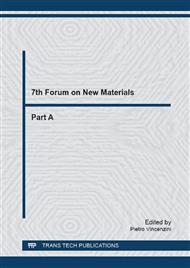[1]
T. F. Otero, Conducting Polymers, Electrochemistry, and Biomimicking Processes, Modern Aspects of Electrochemistry, Springer US, 1999, pp.307-434.
DOI: 10.1007/0-306-46917-0_3
Google Scholar
[2]
T. F. Otero, J. G. Martinez, Biomimetic intracellular matrix (ICM) materials, properties and functions. Full integration of actuators and sensors, Journal of Material Chemistry B, vol. 1, No. 1, 2013, pp.26-38.
DOI: 10.1039/c2tb00176d
Google Scholar
[3]
K. Yamato and K. Kaneto, Tubular linear actuators using conducting polymer, polypyrrole, Analytica Chimica Acta, vol. 568, No. 1-2, 2006, pp.133-137.
DOI: 10.1016/j.aca.2005.12.030
Google Scholar
[4]
A. DellaSanta, D. DeRossi, A. Mazzoldi, Performance and work capacity of a polypyrrole conducting polymer linear actuator, Synthetic Metals, vol. 90, No. 2, 1997, pp.93-100.
DOI: 10.1016/s0379-6779(97)81256-8
Google Scholar
[5]
T. F. Otero, E. Angulo, J. Rodríguez, C. Santamaría, Electrochemomechanical properties from a bilayer: polypyrrole/non-conducting and flexible material - artificial muscle, Journal of Electroanalytical Chemistry, vol. 341, No. 1-2, 1992, pp.369-375.
DOI: 10.1016/0022-0728(92)80495-p
Google Scholar
[6]
Q. Pei, O. Inganas, Conjugated Polymers and the Bending Cantilever Method - Electrical Muscles and Smart Devices, Advanced Materials, vol. 4, No. 4, 1992, pp.277-278.
DOI: 10.1002/adma.19920040406
Google Scholar
[7]
T. F. Otero, J. G. Martinez, J. Arias-Pardilla, Biomimetic electrochemistry from conducting polymers. A review: Artificial muscles, smart membranes, smart drug delivery and computer/neuron interfaces, Electrochimica Acta, vol. 84, 2012, pp.112-128.
DOI: 10.1016/j.electacta.2012.03.097
Google Scholar
[8]
K. Kaneto, M. Kaneko, Y. Min, A.G. MacDiarmid, Artificial muscle: Electromechanical actuators using polyaniline films, Synthetic Metals Vol. 71, 1995, pp.2211-2212.
DOI: 10.1016/0379-6779(94)03226-v
Google Scholar
[9]
W. Takashima, M. Fukui, M. Kaneko, K. Kaneto, Electrochemomechanical deformation in polyaniline films, Japanese Journal of Applied Physics, Vol. 34, 1995, pp.3786-3789.
DOI: 10.1143/jjap.34.3786
Google Scholar
[10]
M. Kaneko, K. Kaneto, Deformation of poly(o-methoxyaniline) Film Induced by polymer Conformation on Electrochemical Oxidation, Polymer Journal, Vol. 33, 2001, pp.104-107.
DOI: 10.1295/polymj.33.104
Google Scholar
[11]
M. Kaneko, K. Kaneto, Electrochemomechanical deformation in poly(o-methoxyaniline), IEICE Transaction on Electronics, Vol. 81, No. 7, 1998, pp.1064-1069.
Google Scholar
[12]
M. Fuchiwaki, W. Takashima, K. Kaneto, Comparative study of electrochemomechanical deformation of poly(3-alkylthiophene)s, polyanilines and polypyllore films, Japanese Journal of Applied Physics. Vol. 40, 2001, pp.7110-7116.
DOI: 10.1143/jjap.40.7110
Google Scholar
[13]
K. Kaneto, Y. Sonoda, W. Takashima, Direct measurement and mechanism of electro-chemomechnical expansion and contraction in polypyrrole films, Japanese Journal of Applied Physics, Vol. 39, 2000, pp.5918-5922.
DOI: 10.1143/jjap.39.5918
Google Scholar
[14]
T. F. Otero, J. G. Martinez, Artificial Muscles: A Tool To Quantify Exchanged Solvent during Biomimetic Reactions, Chemistry of Materials, vol. 24, No. 21, 2012, pp.4093-4099.
DOI: 10.1021/cm302847r
Google Scholar
[15]
T. F. Otero, J. G. Martinez, M. Fuchiwaki, L. Valero, Structural Electrochemistry from Freestanding Polypyrrole Films: Full Hydrogen Inhibition from Aqueous Solutions, Advnced Functional Materials, vol. 24, No. 9, 2014, p.1265–1274.
DOI: 10.1002/adfm.201302469
Google Scholar
[16]
L. Valero, J. G. Martinez, T. F. Otero, Creeping and structural effects in Faradaic artificial muscles, Journal of Solid State Electrochemistry, 2015, pp.1-7.
DOI: 10.1007/s10008-015-2775-1
Google Scholar
[17]
T. F. Otero, J. G. Martínez, B. Zaifoglu, Using reactive artificial muscles to determine water exchange during reactions, Smart Materials Structtures, vol. 22, No. 10, 2013, p.104019.
DOI: 10.1088/0964-1726/22/10/104019
Google Scholar
[18]
M. Fuchiwaki, K. Tanaka, K. Kaneto, Planate conducting polymer actuator based on polypyrrole and its application, Sensors and Actuators -Physics, vol. 150, No. 2, 2009, pp.272-276.
DOI: 10.1016/j.sna.2009.01.011
Google Scholar
[19]
Y. Naka, M. Fuchiwaki, K. Tanaka, A micropump driven by a polypyrrole-based conducting polymer soft actuator, Polymer International, vol. 59, No. 3, 2010, pp.352-356.
DOI: 10.1002/pi.2762
Google Scholar
[20]
M. Fuchiwaki, T. F. Otero, Polypyrrole–para-phenolsulfonic acid/tape artificial muscle as a tool to clarify biomimetic driven reactions and ionic exchanges, Journal of Material Chemistry B, vol. 2, No. 14, pp.1954-1965, mar. (2014).
DOI: 10.1039/c3tb21653e
Google Scholar
[21]
L. Valero, T. F. Otero, J. G. Martínez, Exchanged Cations and Water during Reactions in Polypyrrole Macroions from Artificial Muscles, ChemPhysChem, vol. 15, No. 2, 2014, p.293–301.
DOI: 10.1002/cphc.201300878
Google Scholar
[22]
M. Fuchiwaki, J. G. Martinez, T. F. Otero, Polypyrrole Asymmetric Bilayer Artificial Muscle: Driven Reactions, Cooperative Actuation, and Osmotic Effects, Advanced Functional Materials, vol. 25, No. 10, 2015, pp.1535-1541.
DOI: 10.1002/adfm.201404061
Google Scholar


